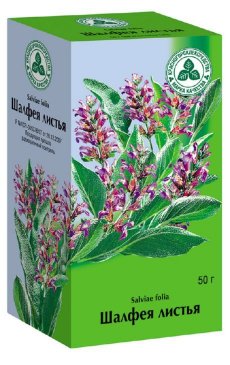Medical expert of the article
New publications
Preparations
Sage leaves
Last reviewed: 03.07.2025

All iLive content is medically reviewed or fact checked to ensure as much factual accuracy as possible.
We have strict sourcing guidelines and only link to reputable media sites, academic research institutions and, whenever possible, medically peer reviewed studies. Note that the numbers in parentheses ([1], [2], etc.) are clickable links to these studies.
If you feel that any of our content is inaccurate, out-of-date, or otherwise questionable, please select it and press Ctrl + Enter.

Sage leaves are a well-known plant among the people. Even ancient healers noticed the medicinal properties of this plant and used it to treat most diseases. Some doctors of Rome and Greece mentioned this herb in their descriptions of their medical practice.
A distinctive feature of sage is that the maximum concentration of medicinal substances accumulates in the plant grown by man. Sage is a semi-shrub, and in nature, old shoots absorb most of the useful substances, but the healing effect of such a plant will be minimal.
Indications sage leaves
Sage leaves are widely used for inflammatory processes in the oral cavity, nasopharynx, and upper respiratory tract. Sage has astringent, disinfectant, anti-inflammatory and antibacterial properties. Tincture from the leaves of the plant is often used for rinsing, lotions, inhalations.
Sage tincture is used for inflammation of the skin, festering wounds, ulcers on the body, burns or frostbite.
Sage leaf infusion can be prescribed as an adjuvant therapy for gastritis, ulcers, low acidity, and gastrointestinal spasms. Sage infusion is also recommended for bladder inflammation.
Sage helps reduce sweating, so it is often used in tuberculosis, fever, and during menopause.
Pharmacodynamics
Sage leaves have versatile properties: antiseptic, anti-inflammatory, expectorant, sage also helps reduce sweating, production of gastric juice. Traditional medicine recommends sage mainly for compresses, baths for inflammation and suppuration of the skin, douching for gargling and mouthwash for various inflammatory processes.
The use of sage tincture is recommended for gastritis with low acidity, stomach ulcers, tuberculosis (to reduce sweating), menopause, and bladder inflammation. Sage is also used as an adjuvant treatment for diabetes (mild form), inflammation of the respiratory organs, gall bladder, liver, and diarrhea.
For antidiabetic treatment, it is better to use sage as part of herbal mixtures.
There is quite a big difference between the effect of sage tinctures on alcohol and water base, since the solubility level of the main substances in them is significantly different. Tinctures on water are recommended for improper digestion, diabetes, tuberculosis in the body, menopause. Alcohol tinctures remove spasms well, have an antiseptic effect, and relieve inflammation.
 [ 5 ]
[ 5 ]
Pharmacokinetics
Dosing and administration
Sage leaves are commonly used to make tinctures.
Take 20 grams of plant leaves and pour a liter of boiling water, then leave for 10-15 minutes, take one glass of this tincture three times a day. In addition, this tincture can be used for rinsing or compresses.
A powder is also used, in which the dried leaves are ground and diluted with a small amount of water. This powder is well suited for external use as a poultice.
For external use, you can also use a decoction (rinses, compresses). Pour 2 tablespoons of sage leaves into a liter of water and boil for 10-15 minutes, cool and use as needed.
 [ 8 ]
[ 8 ]
Use sage leaves during pregnancy
It is not recommended to use sage leaves during pregnancy. The plant contains substances that reduce the level of progesterone, the main hormone for a pregnant woman. If the hormonal background is disrupted, the course of pregnancy can be significantly disrupted, in addition, sage increases uterine contractions, which is also dangerous during pregnancy.
Contraindications
Sage leaves are contraindicated for pregnant women, during breastfeeding (there is a theory that sage reduces milk production in a woman's body), in case of menstrual irregularities, kidney inflammation, and decreased thyroid function.
Excessive and prolonged use (longer than three months) of sage can provoke severe poisoning. Sage leaves are poorly tolerated with reduced muscle and vascular tone (hypotension), and the plant is also not used for severe cough, since taking sage will provoke more severe coughing fits.
Side effects sage leaves
Sage leaves are generally well tolerated, in some cases an allergy to plants may develop. Excessive use may cause rapid heartbeat, tinnitus, convulsions, nausea (sometimes vomiting).
Shelf life
The shelf life of sage leaf is 18 months from the date of manufacture.
Attention!
To simplify the perception of information, this instruction for use of the drug "Sage leaves" translated and presented in a special form on the basis of the official instructions for medical use of the drug. Before use read the annotation that came directly to medicines.
Description provided for informational purposes and is not a guide to self-healing. The need for this drug, the purpose of the treatment regimen, methods and dose of the drug is determined solely by the attending physician. Self-medication is dangerous for your health.

